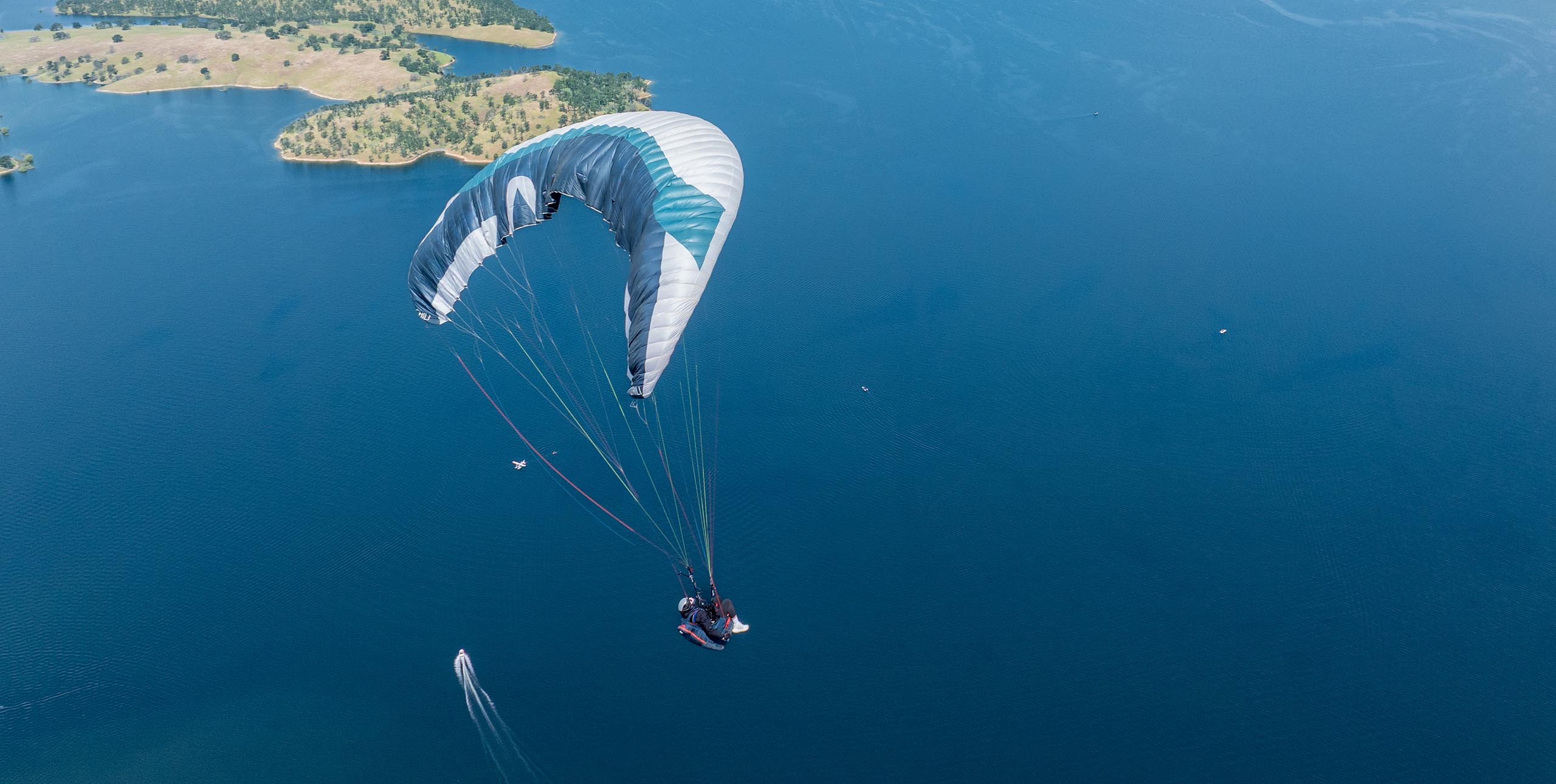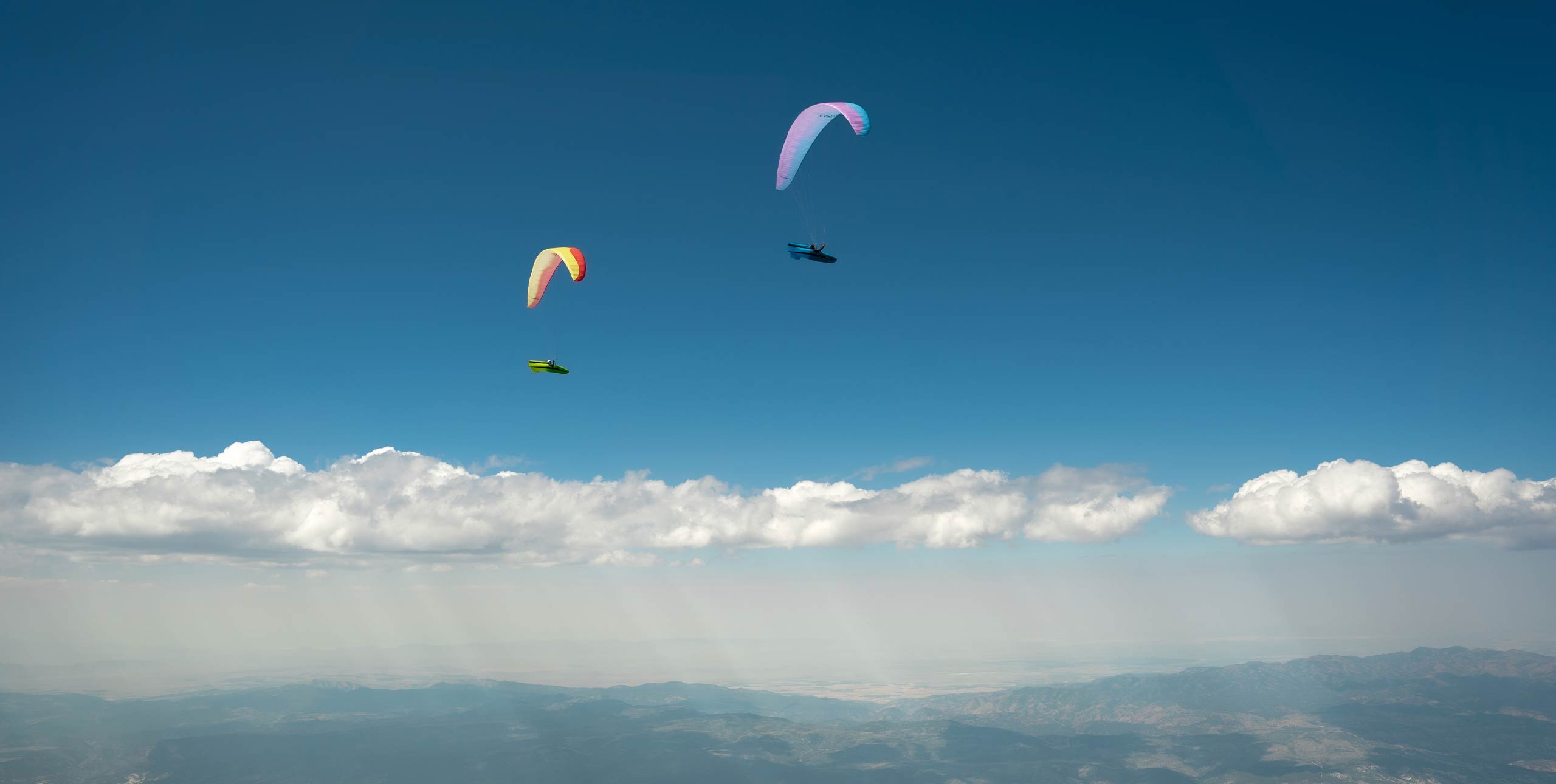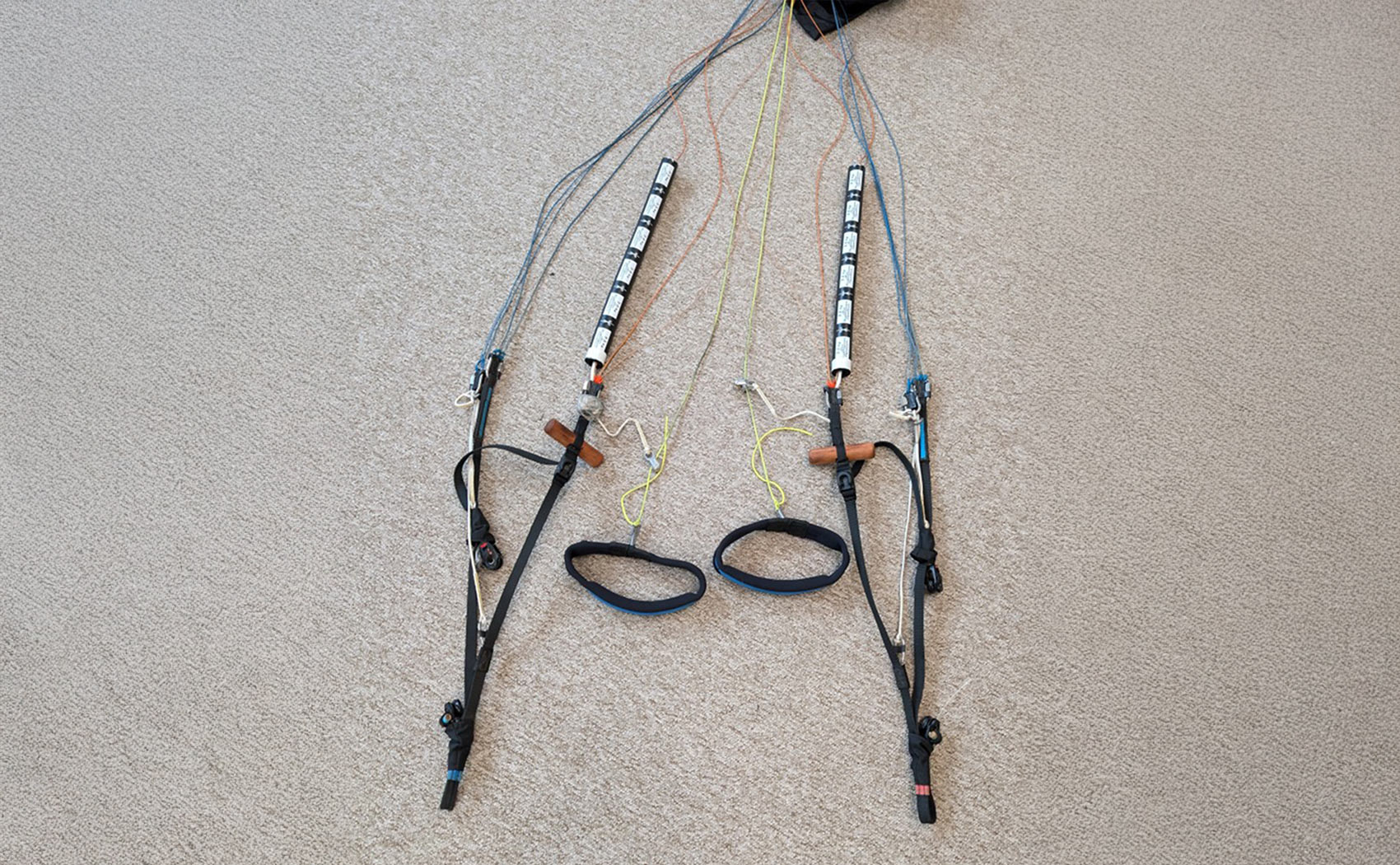
Point of the Mountain, Utah
Canada’s Pete Powell reflects on his long road of learning to paraglide at Point of the Mountain before heading Iquique in Chile for some serious thermalling. Published in Cross Country magazine in 2002
Paragliders the world over rely on some understanding of thermal flying if they ever venture away from their learning slopes. Yes, those first few sled rides were breathtaking, and the hour-long ridge soaring was also thrilling. However, many a learning paraglider pilot soon casts the beady gaze over those inviting multi-coloured flatlands and distant spines, nervously wondering… Could I go there? Can anyone go there? Will I be killed instantly, or slowly mocked to death by the master fliers? Am I tethered forever to this damn ridge, this Rock of Ages?
We soon learn some answers in the bars where talk is cheap, and in the books where the words are big. It is possible to leave the nest on the ridge. Hook a thermal (?) and crank(?) your way up to cloudbase (whatever that is). But how do I learn to use these invisible thermals’. Where do I start?
This dilemma must strike an odd note to those who have fledged in the Alps and other environments where thermals are a regular part of the day’s activity. Places where even a beginner can launch, stagger around blindly until the risers give him a good yank and with a little luck, legs flailing and body flopping, swing up and away.
But there are those of us who live and paraglide in less inviting terrain. Northwestern Ontario, Canada, is such a place. There are ridges to soar, but it’s boreal forest country and the trees are everywhere, waiting with their outstretched branches. Waiting with their sharp points for the adventurous and misjudging. My glider has been repaired three times in 50 hours of flying.
I learned to paraglide at Point of the Mountain, Utah. An excellent learning environment. Dry, warm, lots of instructors to choose from, and no trees. But I don’t live there and, at age fifty-five, have no intentions of fleeing my creditors and resettling’just yet.
So, with a novice license in hand and courage leaking from every pore, I scuttled home. There were no existing paragliding sites there, so I carved out a launch pad near one of our ski resorts (chainsaw-type carving). There being no other paraglider pilots in this part of the world, I got to go first. My ridge is two kilometres long and about 230 metres above the hard deck. The name for the site came easily, ‘Cape Fear’. After one year of flying at the ‘Cape’ I hankered for more. More than just soaring, although the soaring was wonderful even in the dead of winter at -25C, especially with no traffic worries.
I subscribed to a magazine with the unusual name of Cross Country. So, what’s this all about’ this going cross country? Whoa! This looks more like it. I suddenly wanted to go cross country. Apparently, one uses thermals and away one goes.
Attaining ‘thermaleer’ status became my immediate goal. I read everything I could find on the subject, then got in my car and pointed it once again to Utah. I had a three part plan.
The 2,500 km drive allowed me to visit other established paragliding sites along the way- Jackson Hole, Wyoming; Boulder and Aspen, Colorado. I enjoyed some great sled rides to be sure, but the site requirements for mid-day flying were beyond my abilities. Sure, thermal flying was available there, but when I outlined my experience (and I wasn’t about to bullshit) there were a lot of shaking heads. I carried on to Utah.
A week’s worth of glorious gliding in 40C heat of Salt Lake City’s high and dry desert soothed my bruised kite and various frozen body parts.
A manoeuvres clinic at Bear Lake, Utah was phase one of my plan. My thinking was simple. The thermal lexicon abounded with scary words like ‘rowdy’, ‘trashed’ and the horrible ‘spat out the side’. So maybe I’d best experience the wing misadventures in a controlled environment, under the guidance of those that know (Chris Santacroce, Ken Hudonjorgenson, Enleau O’Conner), over water and at a safe (1000m) altitude. Then, and if, I ever intentionally lurched into one of these so-called ‘thermals’, I might be better prepared. The clinic was a great learning experience and a must for every paraglider pilot.
I hauled back to Thunder Bay, Ontario (home) with more confidence. I spent another season studying the nuances of my Cape Fear, with the added armamentarium of big ears/speed bar/competent pitch control etc., and with my ‘Thermaleer’ master plan one-third complete.
The next summer I read more and even suffered through some videos (why do the sound tracks get old so fast?). I signed up for another clinic in Utah; ‘Learn to Thermal in Three Days’ and fuelled the car.
We were three students in the course, with two instructors. For two classroom days we absorbed all we could from the instructors’ combined 17 years experience in competition and cross-country flying. This included exercises ‘the blindfold type’ with a couple of rocks clicking together to simulate a variometer, and a variety of others. It was all good. I was especially happy to sit and soak up their hard-won knowledge. Experience comes at a price, and I was in the buying mood.
We drove into the mountains for the practical sessions. With the meteorology printouts in hand, we sat in the dry grass and spider bushes atop West Mountain, thirty miles south of Salt Lake City. Takeoffs in all directions and landing zones wherever you looked. It was a mellow day with no need to rush. It was wondrous to feel the warm flood of air sweep up the mountainside, to time the cycles-to watch the swifts wheeling and darting as they gobbled up the little insects lifted by the thermals. I began to get a sense of what is was all about. I felt I was as prepared as a low time paraglider and confirmed ridge dog could be. I was bulging with theory. Time to go.
I launched at the beginning of a cycle and drifted away from the mountaintop to gain some terrain clearance, then with the vario still chirping, began my very first 360 in lift. And I kept turning. With a little radio guidance from below I spun up 300 metres in my first fat thermal. Unbelievable! It can be done. It was one of those ‘Eureka!’ deals for me. In the buzz of the post-flight debriefings I happily admitted that the flight was second in thrillability only to my very first-ever paraglide flight. Similar flights followed at different sites in the area. Taking the elevator up was a dream fulfilled. Now to practice. (Part three of my master plan.)
Dateline: Iquique, Chile
For North Americanos, it requires fewer ‘reward miles’ to fly to South America than to Europe. Besides, a flying chum, Ulic Longford was already in Chile with the Canadian Alpine Ski Team, coaching his charges in preparation for the upcoming World Cup season. Ten years ago Ulic had driven north from Santiago after a training camp, and marvelled at the topography. Dry, hilly, mountainous, deserted. After getting his paraglider license the memory of this terrain tugged hard at his flying nucleus. So away we went.
I was expecting mainly a ridge experience in northern Chile, although the ridge goes for about 1000 miles. But the moist sea air, the desert dunes, the 500 metre uplift ridge, the bright sun (30C), well maybe there would be some thermals as well.
We taxied up to launch, ‘Alto Hospicio’ (450m ASL), and immediately latched onto two local pilots, chatting them up on site dangers, landing areas and the like. We had collided head-long with the Spanish language, so there were many diagrams fingered in the sand. Our first flight was two hours plus, mainly because of the buoyant, thermic lift.
After that there was no stopping us. For ten days straight we slashed and hacked our way through every thermal we could find, or that found us. And what a fantastic place to hone one’s thermal technique. If you miscalculate your turning centres and get dumped out the side, you can simply creep back closer to the endless ridge, scratch up a bit and flog away at the next magic cylinder that comes your way.
The ceiling, on even cloudless days was about 1,000 m ASL. The site record is 1,250 m, so you don’t have to worry about supplementary O2, but you do have every opportunity to fly all day, every day in a very forgiving environment. I happened upon a local meteorologist while I was humping back to our hotel and he allowed as how it had never rained during his 14 year posting in Iquique.
So, my education has started. We flew for hours every day. I had my share of folds and tucks, usually when trying to hook a bullet too close to the ground, and plenty of attempts at mapping and coring; at landscaping triggers. All the stuff I had been reading and dreaming about during the long Canadian winters – (the ‘Big Dark’).
I’m sure the ‘Alpenthermaleers’ are chuckling at the lengths I had to go to in my quest, but I too, have a grin. I know what cloudbase is now. I’ve been there.
There are many more cloudbases to visit, many more lessons to learn, but as a three part thermal syllabus, I’d say it’s worked out pretty well.
I have joined the ranks of the Thermaleer, twisting in the wind.
Pete Powell is a 55 year old practising dentist, father of two. Learned to paraglide at Point of the Mountain, Salt Lake City, Utah, USA in 1999 with Steve Mayer, Cloud 9 Paragliding. Current USA rating P3. Total time 50 hours, 180 flights. Flies a 1999 Swing Arcus
Paragliding in Iquique in 2005
Paragliding in Chile
There are many flying sites the entire length of the country. In the south (Santiago de Chile), they do have winter conditions, making for rainy days and unflyable conditions. But as you work your way north, flying turns into a year round affair.
The ability to speak Spanish will make your life a lot easier, especially in the small towns. Very few people speak ANY English.
Costs are less than North America, but not cheap-cheap. The two hour flight from Santiago to Iquique (Airbus 320) was $120 return. (All prices here in US$). Be careful with the overweight baggage issue with the domestic airline, LANChile. The allowance is 20kg., which will not get you very far as a visiting paraglider. We got nailed for $75 in excess. The tactic you might try is to emphasize that you are foreigners, connecting with an international flight. Or, just keep shaking your head and moaning. It seemed to work for us on the return flight, where there were no excess baggage charges(!?)
A nice hotel in Iquique with decent-sized room, ensuite bathroom, breakfast and friendly, helpful staff was $40/night ($20 each). Good phone service in the room, cable tv and clean towels every day. There are less and more expensive places in the city of 250,000. We walked around the downtown at night. There are drugs and associated thugs. We didn’t loiter, and we didn’t get mugged. I got bitten by a scrawny dog, which surprised me into a string of profanity. I should have used a chunk of the sidewalk.
You could camp in one of the many deserted beach coves, but security would be an issue. I wouldn’t leave anything there unattended during your flying. The locals won’t even leave a vehicle at the main launch area. There are poor folk aplenty, and we look rich.
There are clubs and instructors in all the major centres in Chile, and it’s always wise to connect with the locals at any new site. A chap that I would highly recommend is Philip Maltry. He operates a flight school in Iquique, and also is available for guiding services. His address is altazor@entelchile.net
You don’t need a car in Iquique, taxis are everywhere and cheap. The main part of the city is built on a flat, sea-level shoreline. We did our flying 5 km inland of the city, where the endless ridge exists almost the length of the country. After our flights, if we had enough altitude, we would overfly the city ( a bit nerve-wracking at first ) and land on one of the two main, expansive beaches.
There is no glass recycling, so watch out for your kite wherever you land. There are a lot of mangy curs slinking about, so watch out where you fold your kite. When we were there (September, the ‘windy month’) it was ‘kite month’ for the school kids, so at noon the beaches were bristling with dozens of high flying kites. I kept my eyeballs out on stalks.
There were no charges for flying in Iquique. No waivers, no radio concerns, no rating requirements for free flying folks. The seafood is fresh and fabuloso. The wine is inexpensive and excellent. It never rains.
What else do you want?
Updated January 2011











